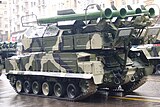Russian Ground Forces
| Ground Forces of the Russian Federation | |
|---|---|
| Сухопутные войска Российской Федерации Suhoputnye voyska Rossiyskoy Federatsii | |
 Emblem of the Russian Ground Forces | |
| Founded | 1550[1] 1992 (current form) |
| Country | Russia |
| Type | Army |
| Size | 280,000 active duty (2021)[2] |
| Part of | |
| Headquarters | Frunzenskaya Embankment 20-22, Moscow |
| Patron | Saint Alexander Nevsky[3] |
| Colors | Red, Black, Gray, Green |
| March | "Forward, infantry!" |
| Anniversaries | 1 October |
| Engagements | Transnistria War Civil War in Tajikistan East Prigorodny Conflict War in Abkhazia 1993 Russian constitutional crisis First Chechen War War of Dagestan 1999 East Timorese crisis Second Chechen War Russo-Georgian War Insurgency in the North Caucasus Military intervention in Ukraine[4] Syrian Civil War Iraqi Civil War |
| Website | structure |
| Commanders | |
| Commander-in-Chief | |
| First Deputy Commander-in-Chief | |
| Deputy Commander-in-Chief | |
| Insignia | |
| Flag |  |
| Patch |  |
| Middle emblem | 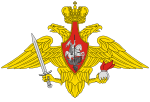 |
| Insignia |  |
The Ground Forces of the Russian Federation (Russian: Сухопутные войска Российской Федерации, tr. Sukhoputnye voyska Rossiyskoy Federatsii, SVR) are the land forces of the Russian Armed Forces.
Mission[]
The primary responsibilities of the Russian Ground Forces are the protection of the state borders, combat on land, the security of occupied territories, and the defeat of enemy troops. The Ground Forces must be able to achieve these goals both in nuclear war and non-nuclear war, especially without the use of weapons of mass destruction. Furthermore, they must be capable of protecting the national interests of Russia within the framework of its international obligations.
The Main Command of the Ground Forces is officially tasked with the following objectives:[6]
- the training of troops for combat, on the basis of tasks determined by the Armed Forces' General Staff
- the improvement of troops' structure and composition, and the optimization of their numbers, including for special troops
- the development of military theory and practice
- the development and introduction of training field manuals, tactics, and methodology
- the improvement of operational and combat training of the Ground Forces
History[]
|
| ||||
|---|---|---|---|---|
|
||||
|
| ||||
|
||||
|
| ||||
|
||||
|
| ||||
|
||||
|
| ||||
|
||||
|
Russian Civil War | ||||
|
||||
|
| ||||
|
||||
|
| ||||
|
||||
| Russian Federation Armed Forces |
|---|
 |
|
| Staff |
| Services (vid) |
|
| Independent troops (rod) |
|
| Special operations force (sof) |
| Other troops |
| Military districts |
| History of the Russian military |
As the Soviet Union dissolved, efforts were made to keep the Soviet Armed Forces as a single military structure for the new Commonwealth of Independent States. The last Minister of Defence of the Soviet Union, Marshal Yevgeny Shaposhnikov, was appointed supreme commander of the CIS Armed Forces in December 1991.[7] Among the numerous treaties signed by the former republics, in order to direct the transition period, was a temporary agreement on general purpose forces, signed in Minsk on 14 February 1992. However, once it became clear that Ukraine (and potentially the other republics) was determined to undermine the concept of joint general purpose forces and form their own armed forces, the new Russian government moved to form its own armed forces.[7]
Russian President Boris Yeltsin signed a decree forming the Russian Ministry of Defence on 7 May 1992, establishing the Russian Ground Forces along with the other branches of the military. At the same time, the General Staff was in the process of withdrawing tens of thousands of personnel from the Group of Soviet Forces in Germany, the Northern Group of Forces in Poland, the Central Group of Forces in Czechoslovakia, the Southern Group of Forces in Hungary, and from Mongolia.
Thirty-seven divisions had to be withdrawn from the four groups of forces and the Baltic States, and four military districts—totalling 57 divisions—were handed over to Belarus and Ukraine.[8] Some idea of the scale of the withdrawal can be gained from the division list. For the dissolving Soviet Ground Forces, the withdrawal from the former Warsaw Pact states and the Baltic states was an extremely demanding, expensive, and debilitating process.[9] As the military districts that remained in Russia after the collapse of the Union consisted mostly of the mobile cadre formations, the Ground Forces were, to a large extent, created by relocating the formerly full-strength formations from Eastern Europe to under-resourced districts. However, the facilities in those districts were inadequate to house the flood of personnel and equipment returning from abroad, and many units "were unloaded from the rail wagons into empty fields."[10] The need for destruction and transfer of large amounts of weaponry under the Treaty on Conventional Armed Forces in Europe also necessitated great adjustments.
Post-Soviet reform plans[]
The Ministry of Defence newspaper Krasnaya Zvezda published a reform plan on 21 July 1992. Later one commentator said it was "hastily" put together by the General Staff "to satisfy the public demand for radical changes."[11] The General Staff, from that point, became a bastion of conservatism, causing a build-up of troubles that later became critical. The reform plan advocated a change from an Army-Division-Regiment structure to a Corps-Brigade arrangement. The new structures were to be more capable in a situation with no front line, and more capable of independent action at all levels. Cutting out a level of command, omitting two out of three higher echelons between the theatre headquarters and the fighting battalions, would produce economies, increase flexibility, and simplify command-and-control arrangements.[12] The expected changeover to the new structure proved to be rare, irregular, and sometimes reversed. The new brigades that appeared were mostly divisions that had broken down until they happened to be at the proposed brigade strengths. New divisions—such as the new 3rd Motor Rifle Division in the Moscow Military District, formed on the basis of disbanding tank formations—were formed, rather than new brigades.
Few of the reforms planned in the early 1990s eventuated, for three reasons: Firstly, there was an absence of firm civilian political guidance, with President Yeltsin primarily interested in ensuring that the Armed Forces were controllable and loyal, rather than reformed.[11][13] Secondly, declining funding worsened the progress. Finally, there was no firm consensus within the military about what reforms should be implemented. General Pavel Grachev, the first Russian Minister of Defence (1992–96), broadly advertised reforms, yet wished to preserve the old Soviet-style Army, with large numbers of low-strength formations and continued mass conscription. The General Staff and the armed services tried to preserve Soviet era doctrines, deployments, weapons, and missions in the absence of solid new guidance.[14]
British military expert, Michael Orr, claims that the hierarchy had great difficulty in fully understanding the changed situation, due to their education. As graduates of Soviet military academies, they received great operational and staff training, but in political terms they had learned an ideology, rather than a wide understanding of international affairs. Thus, the generals—focused on NATO expansion in Eastern Europe—could not adapt themselves and the Armed Forces to the new opportunities and challenges they faced.[15]
Internal crisis of 1993[]
The Russian Ground Forces reluctantly became involved in the Russian constitutional crisis of 1993 after President Yeltsin issued an unconstitutional decree dissolving the Russian Parliament, following its resistance to Yeltsin's consolidation of power and his neo-liberal reforms. A group of deputies, including Vice President Alexander Rutskoi, barricaded themselves inside the parliament building. While giving public support to the President, the Armed Forces, led by General Grachev, tried to remain neutral, following the wishes of the officer corps.[16] The military leadership were unsure of both the rightness of Yeltsin's cause and the reliability of their forces, and had to be convinced at length by Yeltsin to attack the parliament.
When the attack was finally mounted, forces from five different divisions around Moscow were used, and the personnel involved were mostly officers and senior non-commissioned officers.[9] There were also indications that some formations deployed into Moscow only under protest.[16] However, once the parliament building had been stormed, the parliamentary leaders arrested, and temporary censorship imposed, Yeltsin succeeded in retaining power.
Chechen Wars[]
First Chechen War[]
The Chechen people had never willingly accepted Russian rule. With the dissolution of the Soviet Union, the Chechens declared independence in November 1991, under the leadership of a former Air Forces officer, General Dzhokar Dudayev.[17] The continuation of Chechen independence was seen as reducing Moscow's authority; Chechnya became perceived as a haven for criminals, and a hard-line group within the Kremlin began advocating war. A Security Council meeting was held 29 November 1994, where Yeltsin ordered the Chechens to disarm, or else Moscow would restore order. Defense Minister Pavel Grachev assured Yeltsin that he would "take Grozny with one airborne assault regiment in two hours."[18]
The operation began on 11 December 1994 and, by 31 December, Russian forces were entering Grozny, the Chechen capital. The 131st Motor Rifle Brigade was ordered to make a swift push for the centre of the city, but was then virtually destroyed in Chechen ambushes. After finally seizing Grozny amid fierce resistance, Russian troops moved on to other Chechen strongholds. When Chechen militants took hostages in the Budyonnovsk hospital hostage crisis in Stavropol Kray in June 1995, peace looked possible for a time, but the fighting continued. Following this incident, the separatists were referred to as insurgents or terrorists within Russia.
Dzhokar Dudayev was assassinated in a Russian airstrike on 21 April 1996, and that summer, a Chechen attack retook Grozny. Alexander Lebed, then Secretary of the Security Council, began talks with the Chechen rebel leader Aslan Maskhadov in August 1996 and signed an agreement on 22/23 August; by the end of that month, the fighting ended.[19] The formal ceasefire was signed in the Dagestani town of Khasavyurt on 31 August 1996, stipulating that a formal agreement on relations between the Chechen Republic of Ichkeria and the Russian federal government need not be signed until late 2001.
Writing some years later, Dmitri Trenin and Aleksei Malashenko described the Russian military's performance in Chechniya as "grossly deficient at all levels, from commander-in-chief to the drafted private."[20] The Ground Forces' performance in the First Chechen War has been assessed by a British academic as "appallingly bad".[21] Writing six years later, Michael Orr said "one of the root causes of the Russian failure in 1994–96 was their inability to raise and deploy a properly trained military force."[22]
Second Chechen War[]
The Second Chechen War began in August 1999 after Chechen militias invaded neighboring Dagestan, followed quickly in early September by a series of four terrorist bombings across Russia. This prompted Russian military action against the alleged Chechen culprits.
In the first Chechen war, the Russians primarily laid waste to an area with artillery and airstrikes before advancing the land forces. Improvements were made in the Ground Forces between 1996 and 1999; when the Second Chechen War started, instead of hastily assembled "composite regiments" dispatched with little or no training, whose members had never seen service together, formations were brought up to strength with replacements, put through preparatory training, and then dispatched. Combat performance improved accordingly,[23] and large-scale opposition was crippled.
Most of the prominent past Chechen separatist leaders had died or been killed, including former President Aslan Maskhadov and leading warlord and terrorist attack mastermind Shamil Basayev. However, small-scale conflict continued to drag on; as of November 2007, it had spread across other parts of the Russian Caucasus.[24] It was a divisive struggle, with at least one senior military officer dismissed for being unresponsive to government commands: General Colonel Gennady Troshev was dismissed in 2002 for refusing to move from command of the North Caucasus Military District to command of the less important Siberian Military District.[25]
The Second Chechen War was officially declared ended on 16 April 2009.[26]
Reforms under Sergeyev[]
When Igor Sergeyev arrived as Minister of Defence in 1997, he initiated what were seen as real reforms under very difficult conditions.[27] The number of military educational establishments, virtually unchanged since 1991, was reduced, and the amalgamation of the Siberian and Trans-Baikal Military Districts was ordered. A larger number of army divisions were given "constant readiness" status, which was supposed to bring them up to 80 percent manning and 100 percent equipment holdings. Sergeyev announced in August 1998 that there would be six divisions and four brigades on 24-hour alert by the end of that year. Three levels of forces were announced; constant readiness, low-level, and strategic reserves.[28]
However, personnel quality—even in these favored units—continued to be a problem. Lack of fuel for training and a shortage of well-trained junior officers hampered combat effectiveness.[29] However, concentrating on the interests of his old service, the Strategic Rocket Forces, Sergeyev directed the disbanding of the Ground Forces headquarters itself in December 1997.[30] The disbandment was a "military nonsense", in Orr's words, "justifiable only in terms of internal politics within the Ministry of Defence".[31] The Ground Forces' prestige declined as a result, as the headquarters disbandment implied—at least in theory—that the Ground Forces no longer ranked equally with the Air Force and Navy.[31]
Reforms under Putin[]
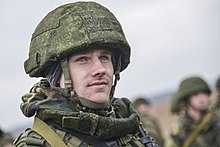
Under President Vladimir Putin, more funds were committed, the Ground Forces Headquarters was reestablished, and some progress on professionalisation occurred. Plans called for reducing mandatory service to 18 months in 2007, and to one year by 2008, but a mixed Ground Force, of both contract soldiers and conscripts, would remain. (As of 2009, the length of conscript service was 12 months.)[32]
Funding increases began in 1999; after some recovery in the Russian economy and the associated rise in income, especially from oil, "Russia's officially reported defence spending [rose] in nominal terms at least, for the first time since the formation of the Russian Federation".[33] The budget rose from 141 billion rubles in 2000 to 219 billion rubles in 2001.[34] Much of this funding has been spent on personnel—there have been several pay rises, starting with a 20-percent rise authorised in 2001; the current professionalisation programme, including 26,000 extra sergeants, was expected to cost at least 31 billion roubles ($1.1 billion USD).[35] Increased funding has been spread across the whole budget, with personnel spending being matched by greater procurement and research and development funding.
However, in 2004, Alexander Goltz said that, given the insistence of the hierarchy on trying to force contract soldiers into the old conscript pattern, there is little hope of a fundamental strengthening of the Ground Forces. He further elaborated that they are expected to remain, to some extent, a military liability and "Russia's most urgent social problem" for some time to come.[36] Goltz summed up by saying: "All of this means that the Russian armed forces are not ready to defend the country and that, at the same time, they are also dangerous for Russia. Top military personnel demonstrate neither the will nor the ability to effect fundamental changes."[36]
More money is arriving both for personnel and equipment; Russian Prime Minister Vladimir Putin stated in June 2008 that monetary allowances for servicemen in permanent-readiness units will be raised significantly.[37] In May 2007, it was announced that enlisted pay would rise to 65,000 roubles (US$2,750) per month, and the pay of officers on combat duty in rapid response units would rise to 100,000–150,000 roubles (US$4,230–$6,355) per month. However, while the move to one year conscript service would disrupt dedovshchina, it is unlikely that bullying will disappear altogether without significant societal change.[38] Other assessments from the same source point out that the Russian Armed Forces faced major disruption in 2008, as demographic change hindered plans to reduce the term of conscription from two years to one.[39][40]
Serdyukov reforms[]
This section needs to be updated. (July 2021) |
A major reorganisation of the force began in 2007 by the Minister for Defence Anatoliy Serdyukov, with the aim of converting all divisions into brigades, and cutting surplus officers and establishments.[41][42] However, this affected units of continuous readiness (Russian: ЧПГ – части постоянной готовности) only. It is intended to create 39 to 40 such brigades by 1 January 2016, including 39 all-arms brigades, 21 artillery and MRL brigades, seven brigades of army air defence forces, 12 communication brigades, and two electronic warfare brigades. In addition, the 18th Machine Gun Artillery Division stationed in the Far East remained, and there will be an additional 17 separate regiments.[citation needed] The reform has been called "unprecedented".
In the course of the reorganization, the 4-chain command structure (military district – field army – division – regiment) that was used until then was replaced with a 3-chain structure: strategic command – operational command – brigade. Brigades are supposed to be used as mobile permanent-readiness units capable of fighting independently with the support of highly mobile task forces or together with other brigades under joint command.[43]
In a statement on 4 September 2009, RGF Commander-in-Chief Vladimir Boldyrev said that half of the Russian land forces were reformed by 1 June and that 85 brigades of constant combat preparedness had already been created. Among them are the combined-arms brigade, missile brigades, assault brigades and electronic warfare brigades.[44]
Reforms under Sergey Shoygu[]
This section needs to be updated. (July 2021) |

After Sergey Shoygu took over the role of minister of defense, the reforms Serdyukov had implemented were redirected and corrected. Sergey Shoygu replaced the purpose of the reforms to instead cover military training. Sergey Shoygu also has helped restore trust with senior officers as well as the defense ministry. He did this a number of ways but one of the ways was integrating himself by wearing a military uniform.[45] Sergey Shoygu helped improve operational readiness by ordering 750 military exercises including some that are very large (Vostok 2018). The exercises also seemed to have helped validate the general direction of reform. the effect of this readiness was seen during Russia's annexation of Crimea in 2014. Since Serdyukov had already completed the unpopular reforms (military downsizing and reorganization), it had been relatively easy for Sergey Shoygu to be conciliatory with the officer corps and Ministry of Defense.[46]
Rearmament has been an important goal of reform. With the goal of 70% modernization by 2020 This was one of the main goals of these reforms. From 1998 to 2001 The Russian Army received almost no new equipment. Sergey Shoygu took a less confrontational approach with the defense industry. By showing better flexibility on terms and pricing, the awarding of new contracts for the upcoming period was much better. Sergey Shoygu promised that future contracts would be awarded primarily to domestic firms. While easing tensions, these concessions also weakened incentives for companies to improve performance.[47]
Structure[]

The President of Russia is the Supreme Commander-in-Chief of the Armed Forces of the Russian Federation. The Main Command (Glavkomat) of the Ground Forces, based in Moscow, directs activities. This body was disbanded in 1997, but reformed by President Putin in 2001 by appointing Colonel General Nikolai Kormiltsev as the commander-in-chief of the ground forces and also as a deputy minister of defense.[48] Kormiltsev handed over command to Colonel General (later General of the Army) Alexey Maslov in 2004, and in a realignment of responsibilities, the Ground Forces Commander-in-Chief lost his position as a deputy minister of defence. Like Kormiltsev, while serving as Ground Forces Commander-in-Chief Maslov has been promoted to General of the Army.
In January 2014, the acting commander of the Russian Ground Forces was Lieutenant General Sergei Istrakov, who was appointed by Russian president Vladimir Putin upon the dismissal of former commander Colonel General Vladimir Chirkin over corruption charges in December 2013.[49][50] Istrakov handed over his position to a new commander on 2 May 2014, Colonel General Oleg Salyukov.
The Main Command of the Ground Forces consists of the Main Staff of the Ground Troops, and departments for Peacekeeping Forces, Armaments of the Ground Troops, Rear Services of the Ground Troops, Cadres of the Ground Troops (personnel), Indoctrination Work, and Military Education.[51] There were also a number of directorates which used to be commanded by the Ground Forces Commander-in-Chief in his capacity as a deputy defence minister. They included NBC Protection Troops of the Armed Forces, Engineer Troops of the Armed Forces, and Troop Air Defence, as well as several others. Their exact command status is now unknown.
Branches of service[]

The branches of service include motorized rifles, tanks, artillery and rocket forces, troop air defense, special corps (reconnaissance, signals, radioelectronic warfare, engineering, nuclear, biological and chemical protection, logistical support, automobile, and the protection of the rear), special forces, military units, and logistical establishments.[52]
The Motorised Rifle Troops, the most numerous branch of service, constitutes the nucleus of Ground Forces' battle formations. They are equipped with powerful armament for destruction of ground-based and aerial targets, missile complexes, tanks, artillery and mortars, anti-tank guided missiles, anti-aircraft missile systems and installations, and means of reconnaissance and control. It is estimated that there are currently 19 motor rifle divisions, and the Navy now has several motor rifle formations under its command in the Ground and Coastal Defence Forces of the Baltic Fleet, the Northeastern Group of Troops and Forces on the Kamchatka Peninsula and other areas of the extreme northeast.[53] Also present are a large number of mobilisation divisions and brigades, known as "Bases for Storage of Weapons and Equipment", that in peacetime only have enough personnel assigned to guard the site and maintain the weapons.
The Tank Troops are the main impact force of the Ground Forces and a powerful means of armed struggle, intended for the accomplishment of the most important combat tasks. As of 2007, there were three tank divisions in the force: the 4th and 10th within the Moscow Military District, and 5th Guards "Don" in the Siberian MD.[54] The 2nd Guards Tank Division in the Siberian Military District and the 21st Tank Division in the Far Eastern MD were disbanded.
The Artillery and Rocket Forces provide the Ground Forces' main firepower. The Ground Forces currently include five or six static defence machine-gun/artillery divisions and seemingly now one division of field artillery—the 34th Guards in the Moscow MD. The previous 12th in the Siberian MD, and the 15th in the Far Eastern MD, seem to have disbanded.[55]
The Air Defense Troops (PVO) are one of the basic weapons for the destruction of enemy air forces. They consist of surface-to-air missiles, anti-aircraft artillery and radio-technical units and subdivisions.[56]
Army Aviation, while intended for the direct support of the Ground Forces, has been under the control of the Air Forces (VVS)[57] since 2003. However, by 2015, Army Aviation will have been transferred back to the Ground Forces and 18 new aviation brigades will have been added.[58] Of the around 1,000 new helicopters that have been ordered under the State Armament Programmes, 900 will be for the Army Aviation.[59]
The Spetsnaz GRU serve under the Ground Forces in peacetime and at the same time are directly subordinated to the Main Directorate of Intelligence (GRU) and will fall under GRU operational control during wartime operations or under special circumstances.[60][61][62] The Ground Forces currently fields 7 spetsnaz brigades of varying sizes and one spetsnaz regiment.
Dispositions since 2010[]
As a result of the 2008 Russian military reforms, the ground forces now consist of armies subordinate to the four new military districts: (Western, Southern, Central, and Eastern Military Districts). The new districts have the role of 'operational strategic commands,' which command the Ground Forces as well as the Naval Forces and part of the Air and Air Defence Forces within their areas of responsibility.[63]
Each major formation is bolded, and directs the non-bolded major subordinate formations. It is not entirely clear to which superior(s) the four operational-strategic commands will report from 1 December 2010, as they command formations from multiple services (Air Force, Ground Forces & Navy). A current detailed list of the subordinate units of the four military districts can be found in the respective articles.[63] During 2009, all 23 remaining divisions were reorganised into four tank brigades, 35 motor-rifle brigades, one prikritiya brigade formed from a machinegun-light artillery division, and three airborne-assault brigades (pre-existing). Almost all are now designated otdelnaya (separate), with only several brigades retaining the guards honorific title.
In 2013, two of these brigades were reactivated as full divisions: the 2nd Guards Tamanskaya Motor Rifle Division and 4th Guards Kantemirovskaya Tank Division. These two divisions marked the beginning of the expansion of the Ground Forces as more brigades are being reformed into full divisions within each military district.
| Formation | Field army | Headquarters location |
|---|---|---|
| Western Military District (Colonel General Alexander Zhuravlyov) (HQ Saint Petersburg) |
1st Guards Tank Army | Odintsovo |
| 6th Combined Arms Army | Agalatovo | |
| 20th Guards Combined Arms Army | Voronezh | |
| Southern Military District (Colonel General Aleksandr Dvornikov)[64] (HQ Rostov-on-Don) |
8th Guards Combined Arms Army | Novocherkassk[65] |
| 49th Combined Arms Army | Stavropol[66] | |
| 58th Combined Arms Army | Vladikavkaz | |
| Central Military District (Lieutenant General )[67] (HQ Yekaterinburg) |
2nd Guards Tank Army | Samara |
| 41st Combined Arms Army | Novosibirsk | |
| Eastern Military District (Lieutenant General )[67] (HQ Khabarovsk) |
5th Combined Arms Army | Ussuriysk |
| 29th Combined Arms Army | Chita | |
| 35th Combined Arms Army | Belogorsk | |
| 36th Combined Arms Army | Ulan Ude | |
| 68th Army Corps | Yuzhno-Sakhalinsk |
Personnel[]
This section needs to be updated. (November 2018) |
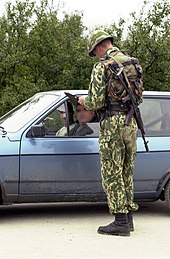
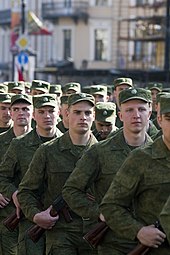


In 2006, the Ground Forces included an estimated total of 395,000 persons, including approximately 190,000 conscripts and 35,000 personnel of the Airborne Forces (VDV).[68] This can be compared to an estimated 670,000, with 210,000 conscripts, in 1995–96.[69] These numbers should be treated with caution, however, due to the difficulty for those outside Russia to make accurate assessments, and confusion even within the General Staff on the numbers of conscripts within the force.[39]
The Ground Forces began their existence in 1992, inheriting the Soviet military manpower system practically unchanged, though it was in a state of rapid decay. The Soviet Ground Forces were traditionally manned through terms of conscription, which had been reduced in 1967 from three to two years. This system was administered through the thousands of military commissariats (Russian: военный комиссариат, военкомат, voyenkomat) located throughout the Soviet Union. Between January and May of each year, every young Soviet male citizen was required to report to the local voyenkomat for assessment for military service, following a summons based on lists from every school and employer in the area.
The voyenkomat worked to quotas sent out by a department of the General Staff, listing how many young men were required by each service and branch of the Armed Forces.[70] (Since the fall of the Soviet Union, draft evasion has skyrocketed; officials regularly bemoan the ten or so percent that actually appear when summoned.) The new conscripts were then picked up by an officer from their future unit and usually sent by train across the country. On arrival, they would begin the Young Soldiers' course, and become part of the system of senior rule, known as dedovshchina, literally "rule by the grandfathers." There were only a very small number of professional non-commissioned officers (NCOs), as most NCOs were conscripts sent on short courses[71] to prepare them for section commanders' and platoon sergeants' positions. These conscript NCOs were supplemented by praporshchik warrant officers, positions created in the 1960s to support the increased variety of skills required for modern weapons.[72]
The Soviet Army's officer-to-soldier ratio was extremely top-heavy, partially in order to compensate for the relatively low education level of the military manpower base and the absence of professional NCOs. Following World War II and the great expansion of officer education, officers became the product of four-to-five-year higher military colleges.[73] As in most armies, newly commissioned officers usually become platoon leaders, having to accept responsibility for the soldiers' welfare and training (with the exceptions noted above). Young officers in Soviet Army units were worked round the clock, normally receiving only three days off per month. Annual vacations were under threat if deficiencies emerged within the unit, and the pressure created enormous stress. Towards the end of the Soviet Union, this led to a decline in morale amongst young officers.[74]
In the early 2000s, many junior officers did not wish to serve—in 2002, more than half the officers who left the forces did so early.[36] Their morale was low, among other reasons because their postings were entirely in the hands of their immediate superiors and the personnel department. "Without having to account for their actions, they can choose to promote or not promote him, to send him to Moscow or to some godforsaken post on the Chinese border."[36]
There is little available information on the current status of women, who are not conscripted, in the Russian Ground Forces. According to the BBC, there were 90,000 women in the Russian Army in 2002, though estimates on numbers of women across the entire Russian Armed Forces in 2000 ranged from 115,000 to 160,000.[75][76] Women serve in support roles, most commonly in the fields of nursing, communications, and engineering. Some officers' wives have become contract service personnel.
Equipment[]
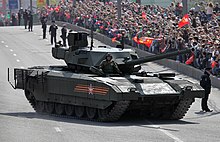
The Russian Ground Forces retain a very large quantity of vehicles and equipment.[77] There is also likely to be a great deal of older equipment in state military storage, a practice continued from the Soviet Union. However, following the collapse of the USSR, the newly independent republics became host to most of the formations with modern equipment, whereas Russia was left with lower-category units, usually with older equipment.[78] As financial stringency began to bite harder, the amount of new equipment fell as well, and by 1998, only ten tanks and about 30 BMP infantry fighting vehicles were being purchased each year.[79]
New equipment, like the Armata Universal Combat Platform, Bumerang and Kurganets-25 will be equipped from 2015 and replace many old tanks, BMPs, BTRs like the T-72, T-90, BMP-1/2/3, and BTR-80 in active service. Funding for new equipment has greatly risen in recent years, and the Russian defence industry continues to develop new weapons systems for the Ground Forces.[80] Level of modern weapons in the Ground Forces is 60 per cent in late 2019.[81][82] Two Iskander-M missile system brigade sets, over 60 Tornado-G MLRS and more than 20 Msta-SM self-propelled howitzers have been received in 2016. More than 70 upgraded Grad-M MLRS have been fielded too.[83] The Russian Ground Forces received two brigade sets of Buk-M3 and Buk-M2 air defence missile complexes in 2016. Troops also received two division sets of Tor-M2 and two of Tor-M2U air defence missile complexes. Moreover, the Forces received Verba MANPADS, more than 130 BMP-3 IFVs and BTR-82A APCs as well as more than 20 Tigr-M armored vehicles equipped with the Arbalet-DM combat module.[84] Russian troops have reportedly received 2,930 new or modernized systems allowing for two missile brigades, two SAM brigades and two SAM regiments, one Spetsnaz brigade, 12 motorized rifle and tank battalions, and three artillery divisions to be reequipped.[85]
The share of modern weapons and equipment in the Ground Forces from 2012 to 2020 increased by 4 times. Over eight years, more than 2.5 thousand units of armored weapons have been delivered to tank formations and military units of the Ground Forces, including more than 1,000 upgraded tanks T-72B3, T-72B3M, T-80BVM and T-90M. The motorized rifle troops received more than 1.5 thousand units of infantry fighting vehicles BMP-3, upgraded BMP-2 and armored personnel carriers BTR-82A (AM).
The missile forces and artillery of the Ground Forces from 2012 to 2020 received over 1.5 thousand units of military equipment - operational-tactical missile systems "Iskander-M", multiple launch rocket systems of the "Tornado" family, self-propelled howitzers "Msta-SM".
Air Defense Troops of the Ground Forces received over 900 units of military equipment - long-range anti-aircraft missile systems S-300V4, short-range and medium-range anti-aircraft missile systems "Tor-M2" and "Buk-M3", portable anti-aircraft missile systems "Verba".[86]
Equipment summary[]
Figures listed as "Active" only include equipment that circulated in active service.
| Type | Active | Reserve |
|---|---|---|
| Main battle tanks | 2,800[87] | ≈16,500[88][89] |
| Infantry fighting vehicles | 5,160[87] | ≈19,500[87] |
| Armoured personnel carriers | 6,100[87] | ≈18,000+[87] |
| Towed artillery | 150[87] | ≈12,415[87] |
| Self-propelled artillery | 1,610[87] | ≈4,260[87] |
| Rocket artillery | 1,352[90] | |
| SAM systems | 2,531[91] |

2K12 Kub
 Russia (400 Units)
Russia (400 Units)

ZSU-23-4 Shilka
 Russia 350 Units
Russia 350 Units
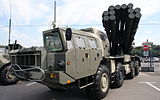
BM-30 Smerch
 Russia 100 Units
Russia 100 Units

S-300V Antey-300/S-300V4
 Russia 2000 Units
Russia 2000 Units
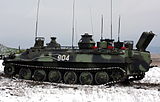
K-612-O/KDKhR-1N
 Russia (Nuclear)
Russia (Nuclear)

9S932T-1 Barnaul-T
 Russia (Air defence)
Russia (Air defence)

BMO-T
 Russia
Russia
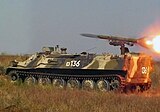
9P149 Shturm-S/SM
 Russia (900 Units)
Russia (900 Units)
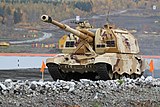
2S19
 Russia
Russia
Buk-M3
 Russia
Russia
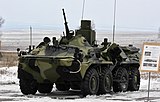
RPM-2
 Russia ( Armoured chemical)
Russia ( Armoured chemical)

T-72
 Russia (7000 Units)
Russia (7000 Units)
Ranks and insignia[]
The newly re-emergent Russia retained most of the ranks of the Soviet Army, with some minor changes. The principal difference from the usual Western style is some variation in generals' rank titles—in at least one case, Colonel General, derived from German usage. Most of the rank names were borrowed from existing German/Prussian, French, English, Dutch, and Polish ranks upon the formation of the modern Russian Army in the late 17th century,[citation needed] and have lasted with few changes of title through the Soviet period.
Officers[]
The rank insignia of commissioned officers.
| Rank group | General/flag officers | Field/senior officers | Junior officers | Officer cadet | ||||||||||||||||||||||||||||||||
|---|---|---|---|---|---|---|---|---|---|---|---|---|---|---|---|---|---|---|---|---|---|---|---|---|---|---|---|---|---|---|---|---|---|---|---|---|

|

|

|

|

|

|

|

|

|

|

|

|

| ||||||||||||||||||||||||
| Ма́ршал росси́йской федера́ции Márshal rossíyskoy federátsii |
Генера́л а́рмии Generál ármii |
Генера́л-полко́вник Generál-polkóvnik |
Генера́л-лейтена́нт Generál-leytenánt |
Генера́л-майо́р Generál-mayór |
Полко́вник Polkóvnik |
Подполко́вник Podpolkóvnik |
Майо́р Majór |
Kапита́н Kapitán |
Старший лейтена́нт Stárshiy leytenánt |
Лейтенант Leytenant |
Mла́дший лейтена́нт Mládshiy leytenánt |
Курсант Kursant | ||||||||||||||||||||||||
Other ranks[]
The rank insignia of non-commissioned officers and enlisted personnel.
| Rank group | Senior NCOs | Junior NCOs | Enlisted | |||||||||||||||||||||||||||||||||
|---|---|---|---|---|---|---|---|---|---|---|---|---|---|---|---|---|---|---|---|---|---|---|---|---|---|---|---|---|---|---|---|---|---|---|---|---|

|

|

|

|

|

|

|

| |||||||||||||||||||||||||||||
| Ста́рший пра́порщик Stárshiy práporshchik |
Пра́порщик Práporshchyk |
Старшина́ Starshyná |
Ста́рший сержа́нт Stárshiy serzhánt |
Сержа́нт Serzhánt |
Мла́дший сержа́нт Mládshiy serzhánt |
Ефре́йтор Efréĭtor |
Рядово́й Ryadovóy | |||||||||||||||||||||||||||||
Commanders[]

Commander-in-chief (1992–1997)[]
- Vladimir Semyonov (1992–1997)
Chief of the Main Directorate (1998–2001)[]
- Yury Bukreyev (1998–2001)
Commander-in-chief (2001–present)[]
- Nikolai Kormiltsev (2001–2004)
- Aleksei Maslov (2004–2008)
- Vladimir Boldyrev (2008–2010)
- Aleksandr Postnikov-Streltsov (2010–2012)
- Vladimir Chirkin (2012–2013)
- Sergei Istrakov (2013–2014)
- Oleg Salyukov (2014–present)
Ground Forces Day[]
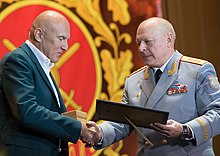
On 31 May 2006, President Vladimir Putin signed decree No. 549 "On the establishment of professional holidays and memorable days in the Armed Forces of the Russian Federation", according to which it was ordered to celebrate Ground Forces Day (Russian: День Сухопутных войск).[93] The date chosen for the holiday commemorates the edict made by Tsar Ivan the Terrible on 1 October 1550 on the placement in Moscow and surrounding districts of a thousand servicemen forming a local brigade of Streltsy, which essentially became a key document in the further formation and development of the Imperial Russian Army.[94] Forces Day was first celebrated on the Preobrazhenskaya Square in Moscow in the Church of the Transfiguration of the Lord, where a bishop's service was held. Before the start of the service, an order of the Minister of Defense Sergei Shoigu and the decree of Patriarch Kirill of Moscow were read, according to which the Cathedral of the Transfiguration of the Lord officially became the main temple of the RF Ground Forces.[95][96] A year later, the holiday was celebrated with the adoption of the Ground Forces Anthem.[97][98]
The following holidays are also celebrated by the Ground Forces: Day of Tankmen, Day of Rocket Forces and Artillery, Day of Air Defense.[99]
Gallery[]

Russian Spetsnaz in mountainous area

Russian sappers unit during a demining operations in Aleppo, Syria

Officers of the Western Military District at the Union Shield 2019 Russian-Belarusian exercise in the Nizhny Novgorod region .

Training of the Military Police of the Western Military District

Russian Military Police training

Russian army gunner during Zapad 2017 military exercise

Russian troops conducting land operations
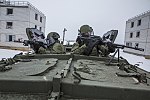
1st Guards Engineer-Sapper Brigade during exercises in Mulino. March 23, 2018.
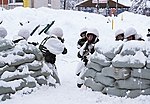
Russian Soldiers During Winter Exercise
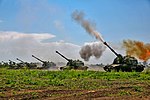
Russian Artillery Units During a Exercise in 2019
See also[]
- Russian Airborne Forces
- Naval Infantry (Russia)
- Awards and emblems of the Ministry of Defence of the Russian Federation
References[]
- ^ "Главная СВ". 470sv.mil.ru. Retrieved 2020-11-30.
- ^ https://fas.org/sgp/crs/row/IF11603.pdf
- ^ Main Cathedral of Russian Armed Forces. Archived 2019-02-02 at the Wayback Machine Retrieved 2019-02-02.
- ^ "Ukraine: With Minsk stalled, Russian sanctions must continue". 3 March 2016. Archived from the original on 2016-03-26. Retrieved 2016-03-29.
- ^ Главнокомандующий Сухопутными войсками Олег Салюков. Биография (in Russian). ITAR TASS. Archived from the original on 2014-05-06. Retrieved 6 May 2014.
- ^ "Official website [Translated by Babelfish and amended for readability]". Russian Ministry of Defence. Archived from the original on January 9, 2007. Retrieved 28 October 2006.
- ^ Jump up to: a b International Institute for Strategic Studies (1992). The Military Balance 1992–3. London: Brassey's. p. 89.
- ^ International Institute for Strategic Studies (1995). The Military Balance 1995–96. London: Brassey's. p. 102.
- ^ Jump up to: a b Muraviev, Alexey D.; Austin, Greg (2001). The Armed Forces of Russia in Asia. Armed Forces of Asia (Illus. ed.). London: I. B. Tauris. p. 257. ISBN 978-1-86064-505-1.
- ^ Orr, Michael (June 1998). "The Russian Armed Forces as a factor in Regional Stability" (PDF). Conflict Studies Research Centre: 2. Archived from the original (PDF) on 2011-03-16. Cite journal requires
|journal=(help) - ^ Jump up to: a b Baev, Pavel (1996). The Russian Army in a Time of Troubles. International Peace Research Institute. Oslo: Sage Publications. p. 67. ISBN 978-0-7619-5187-2.
- ^ Dick, Charles (November 1993). "Russian Views on Future War—Part 3". Jane's Intelligence Review. IHS Jane's: 488. ISSN 1350-6226.
- ^ Arbatov, Alexei (Spring 1998). "Military Reform in Russia: Dilemmas, obstacles, and prospects". International Security. 22 (4): 112. doi:10.2307/2539241. ISSN 0162-2889. JSTOR 2539241.
- ^ Arbatov, 1998, p. 113
- ^ Orr, Michael (January 2003). The Russian Ground Forces and Reform 1992–2002 (Report). Conflict Studies Research Centre. pp. 2–3. D67. Archived from the original on 2010-12-19. Retrieved 2010-09-09.
- ^ Jump up to: a b McNair Paper 34, The Russian Military's Role in Politics (Report). January 1995. Archived from the original on 2008-01-14.
- ^ Finch, Raymond C., III, MAJ. Why the Russian Military Failed in Chechnya (Report). Fort Leavenworth, Kansas: Foreign Military Studies Office. Archived from the original on 2006-10-15.
- ^ Herspring, Dale (July 2006). "Undermining Combat Readiness in the Russian Military". Armed Forces & Society. 32 (4): 512–531. doi:10.1177/0095327X06288030. ISSN 0095-327X. S2CID 110963490. [citing Blandy, C. W. (January 2000). Chechnya: Two Federal Interventions: An interim comparison and assessment (Report). Conflict Studies Research Centre. p. 13. P29. Archived from the original on 2010-12-19. Retrieved 2010-09-09.]
- ^ Scott, Harriet Fast; Scott, William F. (2002). Russian Military Directory. p. 328.
- ^ Trenin, Dmitri V.; Malashenko, Aleksei V. (2004). Russia's Restless Frontier. Washington DC: Carnegie Endowment for International Peace. p. 106. ISBN 0-87003-204-6.
- ^ Orr, Michael (2000). Better or Just Not So Bad? An evaluation of Russian combat performance in the Second Chechen War (PDF). Conflict Studies Research Centre. p. 82. P31. Archived from the original on 2010-12-19. Retrieved 2010-09-09.
- ^ Orr (2000), p. 87
- ^ Orr (2000), pp. 88–90
- ^ "Chechnya and the North Caucasus". AlertNet. Thomson Reuters Foundation. 4 November 2007. Archived from the original on 2011-02-24. Retrieved 8 September 2010.
- ^ "Top Russian general sacked". BBC News World Edition (Europe). BBC. 18 December 2002. Archived from the original on 2007-10-24. Retrieved 8 September 2010.
- ^ "Russia 'ends Chechnya operation". BBC News. BBC. 16 April 2009. Archived from the original on 2011-02-08. Retrieved 2011-03-01.
- ^ Parchomenko, Walter (Winter 1999–2000). "The State of Russia's Armed Forces and Military Reform". Parameters: The U.S. Army's Senior Professional Journal: 98–110. ISSN 0031-1723. Archived from the original on 2010-11-04. Retrieved 2010-09-09.
- ^ Armeiskii Sbornik, Aug 1998, FBIS-UMA-98-340, 6 Dec 98 'Russia: New Look of Ground Troops'.
- ^ Krasnaya Zvezda 28 January and 9 February 1999, in Austin & Muraviev, 2000, p. 268, and M.J. Orr, 1998, p. 3
- ^ Muraviev and Austin, 2001, p. 259
- ^ Jump up to: a b Orr, 2003, p. 6
- ^ The World Factbook. United States Government Printing. 2006. ISBN 0-16-076547-1.
- ^ International Institute for Strategic Studies (2000). The Military Balance, 2000–2001. The Military Balance : Annual Estimates of the Nature and Size of the Military Forces of the Principal Powers. Oxford University Press. p. 115. ISBN 978-0-19-929003-1. ISSN 0459-7222.
- ^ International Institute for Strategic Studies (2001). The Military Balance, 2001–2002. The Military Balance : Annual Estimates of the Nature and Size of the Military Forces of the Principal Powers (Pap/Map ed.). International Institute for Strategic Studies. p. 109. ISBN 978-0-19-850979-0. ISSN 0459-7222.
- ^ International Institute for Strategic Studies. "The Military Balance". The Military Balance : Annual Estimates of the Nature and Size of the Military Forces of the Principal Powers. International Institute for Strategic Studies. Russia. ISSN 0459-7222. (recent editions)
- ^ Jump up to: a b c d Goltz, Alexander (2004). "Military Reform in Russia and the Global War Against Terrorism". Journal of Slavic Military Studies. Routledge. 17: 30–34. doi:10.1080/13518040490440647. ISSN 1351-8046. S2CID 154254640.
- ^ "Russia's public sector wages to rise 30% from Dec. 1 – PM Putin". RIA Novosti. RIA Novosti. 29 June 2008. Russia. Archived from the original on 2010-01-28. Retrieved 8 September 2010.
- ^ Giles, Keir (May 2007). Military Service in Russia: No New Model Army (PDF). Conflict Studies Research Centre.
- ^ Jump up to: a b Giles, Keir (October 2006). Where Have All The Soldiers Gone? Russian military manpower plans versus demographic reality (Report). Conflict Studies Research Centre.
- ^ "How are the mighty fallen". The Economist. 2008-09-18. Retrieved 2008-09-21. (subscription required)
- ^ Yegorov, Ivan (18 December 2008). "Serdyukovґs radical reform". Russia Beyond the Headlines. Rossiyskaya Gazeta. Archived from the original on 2010-09-13. Retrieved 8 September 2010.
- ^ "Russia creates 20 motorized infantry brigades". RIA Novosti. RIA Novosti. RIA Novosti. 20 March 2009. Russia. Archived from the original on 2011-11-20. Retrieved 8 September 2010.
- ^ "Russia's military reform still faces major problems". Archived from the original on 2010-05-28. Retrieved 2010-11-09.
- ^ Russia Reshapes Army Structure to U.S.-Style Brigades, October 5, 2009
- ^ "Russia's Defense Minister Sergei Shoigu Survives Government Reshuffle". Jamestown. Retrieved 2020-07-11.
- ^ Gorenburg, Dmitry (2013-06-14). "The Russian Military under Sergei Shoigu: Will the Reform Continue?". PonarsEuarasia – Policy Memos.
- ^ "Sergei Shoigu: Progress Report on Military Modernization". www.csis.org. Retrieved 2020-07-11.
- ^ Kormiltsev was a Colonel General when he became Commander-in-Chief of the Ground Forces, but after about two years in the position was promoted to General of the Army in 2003. Profile via FBIS, Kormiltsev Biography Archived 2015-04-02 at the Wayback Machine, accessed September 2007
- ^ "Putin Fires Military Commander Over Bribe Charges" Archived 2014-04-13 at the Wayback Machine, The Moscow Times (20 Dec 2013)
- ^ "Главкома Сухопутных войск винят в коррупции" Archived 2014-04-13 at the Wayback Machine, dni.ru (Russian) (19 Dec 2013)
- ^ Scott and Scott, Russian Military Directory 2004, p. 118
- ^ Babakin, Alexander (August 20–26, 2004). "Approximate Composition and Structure of the Armed Forces After the Reforms". Nezavisimoye Voyennoye Obozreniye [Independent Military Review] (31).
- ^ IISS Military Balance, various issues
- ^ International Institute for Strategic Studies (2007). Christopher Langton (ed.). The Military Balance, 2007. The Military Balance : Annual Estimates of the Nature and Size of the Military Forces of the Principal Powers (Revised ed.). Routledge. ISBN 978-1-85743-437-8. ISSN 0459-7222.
- ^ V.I. Feskov et al. 2004 is the source for the designations, while vad777's website is the source for their disbandment. See also Michael Holm, 12th Artillery Division Archived 2015-05-19 at the Wayback Machine and http://www.ww2.dk/new/army/arty/15gvad.htm Archived 2015-05-19 at the Wayback Machine
- ^ Butowsky, p. 81
- ^ Butowsky, p. 83
- ^ Moscow Defense Brief #2, 2010 p. 23
- ^ Moscow Defense Brief #1, 2011 p. 15
- ^ ГРУ (Главное Разведывательное Управление) ГШ ВС РФ. Russian Military Analysis (in Russian). Retrieved December 30, 2012.
- ^ Военно-Морской Флот. Russian Military Analysis (in Russian). Retrieved December 31, 2012.
- ^ Security, Global. "Spetsnaz Order of Battle". GlobalSecurity.org. Retrieved 27 April 2017.
- ^ Jump up to: a b [1] Ria Novosti 2010 Archived February 28, 2012, at the Wayback Machine
- ^ Milenin, Andrei (20 September 2016). "Александр Дворников назначен командующим войсками ЮВО" [Aleksandr Dvornikov appointed commander of the Southern Military District]. Isvestia (in Russian). Archived from the original on 2016-10-01. Retrieved 2 October 2016.
- ^ Алексей Рамм, Евгений Андреев (2017-03-17). "В Южном военном округе появится новая армия". Известия (in Russian). Archived from the original on 2017-03-19. Retrieved 2017-03-20.
- ^ Ilyin, Igor (9 January 2014). "Сергей Севрюков принял штандарт командующего 49-й общевойсковой армией" [Sergey Sevryukov accepted command of the 49th Combined Arms Army]. www.stapravda.ru (in Russian). Stavropol Pravda. Archived from the original on 2016-02-25. Retrieved 2016-02-25.
- ^ Jump up to: a b Pinchuk, Alexander; Khudoleyev, Viktor (29 November 2017). "Штандарты в надёжных руках" [Standards in Safe Hands]. Krasnaya Zvezda (in Russian). Archived from the original on 2017-12-01. Retrieved 23 December 2017.
- ^ International Institute for Strategic Studies (2006). Christopher Langton (ed.). The Military Balance 2006. The Military Balance : Annual Estimates of the Nature and Size of the Military Forces of the Principal Powers (106 ed.). Routledge. p. 154. ISBN 978-1-85743-399-9. ISSN 0459-7222.
- ^ Also an IISS estimate.
- ^ Schofield, Carey (1991). Inside the Soviet Army. London: Headline. pp. 67–70. ISBN 978-0-7472-0418-3.
- ^ Suvorov, Viktor (1982). Inside the Soviet Army. London: Hamish Hamilton. ISBN 978-0-241-10889-5. (gives the figure of six months with a training division)
- ^ Odom, William E. (1998). The Collapse of the Soviet Military. Yale University Press. p. 43. ISBN 0-300-07469-7.
- ^ Odom, pp. 40–41
- ^ Odom, p. 42
- ^ Quartly, Alaan (8 March 2003). "Miss Shooting Range crowned". BBC News. Archived from the original on 2008-11-23. Retrieved 2011-03-01. (It is quite possible that the BBC reporter became confused between the Army (Ground Forces) and the entire Armed Forces, given their usual title in Russian of Armiya.)
- ^ Matthews, Jennifer G. (Fall–Winter 2000). "Women in the Russian Armed Forces – A Marriage of Convenience?". Minerva: Quarterly Report on Women and the Military. 18 (3/4). ISSN 1573-1871.
- ^ IISS 2006, p. 155
- ^ Austin and Muraviev, 2001, pp. 277–278
- ^ Baranov, Nikolai, "Weapons must serve for a long while", Armeiskii sbornik, March 1998, no. 3, pp. 66–71, cited in Austin and Muraviev, 2001, p. 278. See also Mil Bal 95/96, p. 110
- ^ "Russia's new main battle tank to enter service 'after 2010'". RIA Novosti. RIA Novosti. RIA Novosti. 10 July 2008. Archived from the original on 2008-10-01. Retrieved 2008-10-10.
- ^ Выступление министра обороны РФ генерала армии Сергея Шойгу на расширенном заседании Коллегии Минобороны Archived 2016-12-24 at the Wayback Machine armstrade.org. 2016.
- ^ "ЦАМТО / Новости / Уровень обеспеченности частей постоянной готовности СВ современным вооружением и техникой доведен до 60 проц".
- ^ Over 60 Tornado-G MLRS and 20 Msta-SM howitzers delivered to Russian Army in 2016 armyrecognition.com. 29 December 2016.
- ^ "Два бригадных комплекта ЗРК «Бук-М3» и «Бук-М2» получили Сухопутные войска в прошлом году : Министерство обороны Российской Федерации". Archived from the original on 2017-01-13. Retrieved 2017-01-15.
- ^ "Расширенное заседание коллегии Министерства обороны". Archived from the original on 2017-01-16. Retrieved 2017-01-15.
- ^ "ЦАМТО / / Доля современных образцов вооружения и техники Сухопутных войск РФ с 2012 по 2020 годы выросла в 4 раза".
- ^ Jump up to: a b c d e f g h i Military Balance 2020. p. 196.
- ^ T-72 Archived 2013-10-25 at archive.today, warfare.ru – Russian Military Analysis. Retrieved on 8 January 2014.
- ^ T-80 Archived 2014-01-08 at the Wayback Machine, warfare.ru – Russian Military Analysis. Retrieved on 8 January 2014.
- ^ Multiple Rocket Launchers database Archived 2013-10-24 at archive.today, warfare.ru – Russian Military Analysis. Retrieved on 2 January 2013.
- ^ SAM systems Archived 2013-12-27 at the Wayback Machine, warfare.ru – Russian Military Analysis. Retrieved on 2 January 2013.
- ^ Jump up to: a b "Указ Президента Российской Федерации от 11 марта 2010 года № 293 "О военной форме одежды, знаках различия военнослужащих и ведомственных знаках отличия"". rg.ru (in Russian). Российской газеты. 12 March 2010. Retrieved 26 May 2021.
- ^ Указ Президента Российской Федерации от 31 мая 2006 г. № 549 "Об установлении профессиональных праздников и памятных дней в Вооружённых силах Российской Федерации". КонсультантПлюс. Retrieved 2015-10-15.
- ^ Иван Грозный заложил основы русской регулярной армии
- ^ Храм Преображения Господня на Преображенской площади в Москве стал головным храмом Сухопутных войск. Министерства обороны РФ. Retrieved 2015-10-15.
- ^ Пестерева, Анна. (8 October 2015). Храм Преображения Господня стал главным храмом сухопутных войск. Восточный округ. 37 (126): 3. Archived from the original on 2016-03-05.
- ^ "На праздновании Дня Сухопутных войск был презентован их гимн «Вперед, пехота!» : Министерство обороны Российской Федерации".
- ^ ""Вперед, пехота!": Группа "Любэ" исполнила новый гимн сухопутных войск". October 2016.
- ^ День войск противовоздушной обороны (День войск ПВО) — 11 апреля. История и особенности праздника в проекте Календарь Праздников 2010
Bibliography[]
- Arbatov, Alexei (1998). "Military Reform in Russia: Dilemmas, Obstacles, and Prospects". International Security. The MIT Press. 22 (4): 83–134. doi:10.2307/2539241. JSTOR 2539241.
- Austin, Greg & Muraviev, Alexey D. (2001). The Armed Forces of Russia in Asia. Tauris. ISBN 1-86064-485-6.
- Babakin, Alexander (August 20–26, 2004). "Approximate Composition and Structure of the Armed Forces After the Reforms" (31). Nezavisimoye Voyennoye Obozreniye (Independent Military Review). Cite journal requires
|journal=(help) - Baev, Pavel (1996). The Russian Army in a Time of Troubles. Oslo: International Peace Research Institute. ISBN 0-7619-5187-3.
- Baumgardner, Neil. "Russian Armed Forces Order of Battle". Archived from the original on 2009-10-22.
- Butowsky, Piotr (July 2007). "Russia Rising". Air Forces Monthly. Cite journal requires
|journal=(help) - Central Intelligence Agency (2006). "World Fact Book".
- Dick, Charles. (November 1993). "Russian Views on Future War, Part 3". Jane's Intelligence Review.
- "How are the mighty fallen". The Economist. 2005-06-30.
- Fes'kov, V.I.; Golikov, V.I. & K.A. Kalashnikov (2004). The Soviet Army In The Years Of The Cold War 1945–1991. Tomsk University Publishing House. ISBN 5-7511-1819-7.
- Finch, Raymond C. "Why the Russian Military Failed in Chechnya". Fort Leavenworth, KS: Foreign Military Studies Office. Archived from the original on 2006-10-15.
- Galeotti, Mark (February 1997). "Moscow's armed forces: a city's balance of power". Jane's Intelligence Review.
- Giles, Keir (May 2007). "Military Service in Russia: No New Model Army" (PDF). CSRC. Cite journal requires
|journal=(help) - Golts, Alexander (2004). "Military Reform in Russia and the Global War Against Terrorism". Journal of Slavic Military Studies. 17: 29–41. doi:10.1080/13518040490440647. S2CID 154254640.
- Herspring, Dale (July 2006). "Undermining Combat Readiness in the Russian Military". 32 (4). Armed Forces & Society. Cite journal requires
|journal=(help) - "The Military Balance". International Institute for Strategic Studies.
- Lenskii, A.G. & Tsybin, M.M. (2001). The Soviet Ground Forces in the Last Years of the USSR. St Petersburg: B&K Publishers.
- Lukin, Mikhail & Stukalin, Aleksander (14 May 2005). "Vsya Rossiyskaya Armiya". Moscow: Kommersant-Vlast. Cite journal requires
|journal=(help) - James H. Brusstar & Ellen Jones (January 1995). "McNair Paper 34, The Russian Military's Role in Politics". Archived from the original on 2008-01-14.
- Odom, William E. (1998). The Collapse of the Soviet Military. Yale University Press. ISBN 0-300-07469-7.
- Orr, Michael (June 1998). "The Russian Armed Forces as a factor in Regional Stability". CSRC. Cite journal requires
|journal=(help) - Orr, Michael (2000). "Better or Just Not So Bad? An Evaluation of Russian Combat Performance in the Second Chechen War". CSRC. Cite journal requires
|journal=(help) - Orr, Michael (2003). "The Russian Ground Forces and Reform 1992–2002". Cite journal requires
|journal=(help) - Parchomenko, Walter (1999–2000). "The State of Russia's Armed Forces and Military Reform". Parameters (Journal of the US Army War College). Cite journal requires
|journal=(help) - Quartly, Alan (8 March 2003). "Miss Shooting Range crowned". BBC News.
- Robinson, Colin (2005). "The Russian Ground Forces Today: A Structural Status Examination". Journal of Slavic Military Studies. 18 (2): 189–206. doi:10.1080/13518040590944421. S2CID 145691472.
- Schofield, Carey (1991). Inside the Soviet Army. London: Headline. ISBN 0-7472-0418-7.
- Scott, Harriet Fast & Scott, William F. Russian Military Directories 2002 & 2004
- Suvorov, Viktor (1982). Inside the Soviet Army. London: Macmillan. ISBN 0-586-05978-4.
- Turbiville, Graham H. (1995). Mafia in Uniform: The Criminalisation of the Russian Armed Forces. Fort Leavenworth: U.S. Army Foreign Military Studies Office.
External links[]
 Media related to Army of Russia at Wikimedia Commons
Media related to Army of Russia at Wikimedia Commons
- Russian Ground Forces
- Military of Russia










